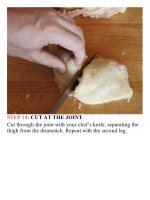The food lab better home cooking through science ( PDFDrive ) 130
Bạn đang xem bản rút gọn của tài liệu. Xem và tải ngay bản đầy đủ của tài liệu tại đây (173.27 KB, 2 trang )
What else can you do to keep the yolks from
overcooking? Well, here’s another thing we know: egg
yolks contain far more fat than egg whites. Luckily for us
here,fatisanexcellentinsulator—thatis,ittransfersenergy
less efficiently than water does (that’s why whales are
covered in blubber).We can use this fact to our advantage
by adjusting the pan temperature. I cooked eggs in three
different pans at three different heat settings just until the
whiteswereset.
• Over low heat, the yolks came out completely firm and
chalkyatthebottom,withjustaverythinlayerofbarely
liquidyolkatthetop.Thewhiteswereextremelyrubbery
and dry in all but the thickest part just around the yolk.
With gentle heat and an extended cooking time, the
differencesinconductivitybetweentheeggyolksandthe
eggwhitesdon’thaveasstronganeffectontheircooking
rates—theybasicallycookinthesametime.Additionally,
the egg whites were pure white, with no crisping or
browning at all on the bottom surface. Some folks like
theireggwhitesthisway.Ithinkthosepeoplesecretlyjust
wantpoachedeggs.
• Over medium heat, there was still a good amount of
liquidyolkatthetopoftheegg,whilethebottomhalfof
theyolkbecamequitefirm.Thewhitestookonatouchof
browning (even more if I used butter instead of oil—the
milk proteins in the butter brown and stick to the eggs).
Thisisagoodcompromiseforfolkswholikesomeliquid
yolkbutdon’twanttheirwhitestoshowanytransparency
atall.
• Over high heat, you can get whites that are completely
set with yolks that are still almost completely liquid, but
you run into another problem: the bottom of the eggs
burnslongbeforetherestoftheeggisreadytoeat.
For the simplest fried eggs, moderate heat is the way to
go.Whetheryou’reusingbutteroroilmakeslittledifference
in the cooking, as long as you make sure that the milk
proteins in your butter don’t burn before you slip the eggs
into the pan; it’s best to add them just after the foaming
subsides. (This is an indication that the water in the butter
hascompletelyevaporatedandthepanissomewhereinthe
250°Frange).Butterwillgiveyouricherflavoranddeeper
browning, while oil will give you cleaner egg flavor and
slightly crisper bottoms—it’s all down to personal









